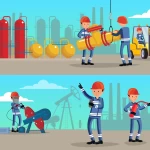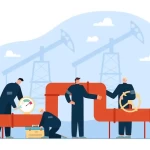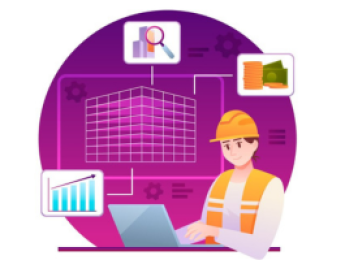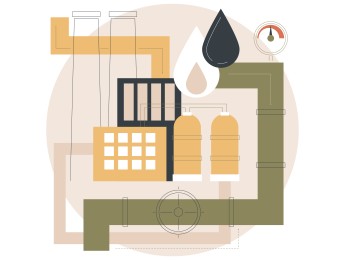- Table of Contents
- Introduction
- What Is Cathodic Protection (CP)?
- Cathodic Protection and Its Method of Operation
- Galvanic Anode Systems
- Impressed Current Systems
- Types of Cathodic Protection
- Applications of Cathodic Protection in the Oil and Gas Industry
- Pipelines
- Storage Tanks
- Well Casings
- Offshore Platforms
- Products to Support Cathodic Protection Systems
- Anodes
- Rectifiers
- Reference Electrodes
- Cabling
- Junction Boxes
- Test Stations
- The Importance of Cathodic Protection in the Oil and Gas Industries
- Safety
- Environmental Protection
- Asset Preservation
- Regulatory Compliance
- Limitations of Cathodic Protection
- Effectiveness Against Specific Corrosion Types
- Regular Inspection and Maintenance
- Influence of External Factors
- Complexity and Cost
- Wireless Remote Monitoring and Control of CP Systems
- 1. Real-Time Data
- 2. Remote Adjustments
- 3. Historical Data Analysis
- Cathodic Protection Monitoring
- 1. Measuring Potential
- 2. Component Inspection
- 3. Current Flow and Voltage Checks
- How CP Monitoring Enhances System Reliability and Increases Efficiency
- 1. Early Issue Detection
- 2. Optimised Performance
- 3. Cost Savings
- 4. Regulatory Compliance
- Conclusion
Introduction
The oil and gas industry is the lifeblood of our modern world, powering everything from our homes to our cars and industries. However, the infrastructure that supports this industry faces a relentless adversary: corrosion. Corrosion, the gradual degradation of metal structures due to chemical reactions with their environment, poses a significant threat to the integrity of pipelines, storage tanks, and other critical components. The industry relies on a powerful ally, Cathodic Protection (CP), to combat this insidious foe. This comprehensive guide will delve deep into the world of cathodic protection, exploring its mechanisms, types, applications, supporting products, importance, and limitations. Additionally, we'll discuss how remote monitoring and control technologies have revolutionised CP systems, ensuring their reliability and efficiency.
What Is Cathodic Protection (CP)?
At its core, cathodic protection is a corrosion prevention technique employed to safeguard metal structures from the destructive forces of their environment. It does so by introducing an electrical current into the metal structure, effectively forcing it to act as a cathode. This, in turn, prevents corrosion by making the metal structure less susceptible to the electrochemical reactions that cause it to deteriorate. In essence, CP sacrifices a more easily corroded metal, known as the anode, to protect the more critical metal, the cathode. This ingenious process ensures that vital infrastructure in the oil and gas industry remains safeguarded from corrosion, ultimately preventing catastrophic failures.
Cathodic Protection and Its Method of Operation
The method of operation of cathodic protection is rooted in the fundamental principles of corrosion. Corrosion occurs when a metal reacts with its environment, forming oxides or other compounds that weaken the metal's structure over time. This electrochemical process involves the flow of electrons between two key elements: the anode and the cathode.
When a metal corrodes, it acts as the anode in the electrochemical cell, where metal atoms lose electrons and become ions. These metal ions are released into the surrounding environment, leading to the deterioration of the metal structure. This is a fundamental process of nature, and it occurs whenever metal is exposed to moisture and oxygen.
Cathodic protection works by strategically introducing a sacrificial anode or utilising an impressed current to modify the electrochemical process. Let's delve into each method:
Galvanic Anode Systems
In galvanic anode systems, a more reactive metal, such as zinc or magnesium, is electrically connected to the metal structure that requires protection. This sacrificial anode corrodes instead of the protected metal, effectively becoming the sacrificial anode in the electrochemical cell. Doing so releases electrons and metal ions into the environment, preventing the original metal from corroding. This approach is particularly effective in smaller structures or situations where maintenance efforts should be minimised.
Impressed Current Systems
On the other hand, Impressed current systems employ an external power source to drive a direct current (DC) through the protected metal structure. The electrical current is supplied by anodes made of materials like graphite, mixed metal oxide (MMO), or platinum-coated titanium. Unlike galvanic anode systems, where the anode itself corrodes, impressed current systems allow for a high degree of control. They work by injecting electrons into the protected structure, creating a cathodic environment that discourages the metal from corroding. Impressed current systems are preferred for larger structures or more aggressive corrosion environments, where precise control over protection levels is crucial.
In both methods, cathodic protection alters the electrochemical process, effectively redirecting the flow of electrons and ions to safeguard the critical infrastructure within the oil and gas industry. This strategy ensures the longevity and structural integrity of pipelines, storage tanks, well casings, and offshore platforms, contributing significantly to the industry's safety and operational efficiency.
Types of Cathodic Protection
Let's examine the usage of cathodic protection within the oil and gas industry to understand its diverse applications better.
Applications of Cathodic Protection in the Oil and Gas Industry
The oil and gas industry is vast and encompasses numerous critical infrastructure elements. Here's a look at how cathodic protection is utilised to safeguard these components:
Pipelines
Pipelines are the oil and gas industry's lifelines, stretching vast distances to transport valuable resources. These critical components face a continuous battle against corrosion, especially in environments where moisture and soil conditions can accelerate metal deterioration. Cathodic protection is indispensable for safeguarding pipelines, as it creates a protective shield around the entire pipeline length. This ensures that even in harsh conditions, the structural integrity of the pipelines is preserved. Without CP, corrosion-related failures could lead to leaks, spills, environmental disasters, and significant economic losses for the industry.
Storage Tanks
Storage tanks, whether located underground or aboveground, are another vital component of the industry's infrastructure. These tanks house vast quantities of oil and gas, making them a high-value asset. However, they are susceptible to corrosion, primarily due to the corrosive nature of the substances they contain. Without cathodic protection, corrosion can compromise the tank's structural integrity, leading to leaks, contamination, and costly cleanup efforts. CP systems provide a cost-effective and reliable solution, ensuring storage tanks' longevity and the stored resources' safety.
Well Casings
Well casings are pivotal in extracting oil and gas from beneath the Earth's surface. These casings are exposed to various corrosive elements, including the corrosive fluids present in the geological formations they traverse. If left unprotected, corrosion can weaken well casings, jeopardising the safety and efficiency of extraction operations. Cathodic protection creates a protective barrier around well casings, preserving their integrity and ensuring the uninterrupted flow of valuable resources.
Offshore Platforms
Offshore platforms face some of the harshest corrosion challenges in the oil and gas industry. These structures are constantly under threat due to the corrosive forces of saltwater and harsh marine environments. Without effective protection, corrosion can weaken the structural components of offshore platforms, posing serious safety risks to personnel and the environment. Cathodic protection systems are essential for extending the service life of these critical structures. They create a corrosion-resistant shield that helps offshore platforms withstand the relentless onslaught of the elements, ensuring the safety of offshore workers and the longevity of these costly installations.
Cathodic protection's applications in the oil and gas industry are varied and crucial for maintaining safety, preserving assets, and preventing environmental disasters. It is a testament to the industry's commitment to responsible resource extraction and sustainable operations in the face of corrosion-related challenges.
Products to Support Cathodic Protection Systems
To implement effective cathodic protection systems, a variety of products are utilised in the oil and gas industry:
Anodes
Anodes are the workhorses of cathodic protection systems. They come in various shapes, materials, and sizes, allowing for customisation to specific applications. Sacrificial anodes, often made of zinc or magnesium, are designed to corrode gradually, diverting the destructive forces of corrosion away from the protected structure. In contrast, impressed current anodes, such as those made from mixed metal oxide (MMO) or platinum-coated titanium, inject a controlled electrical current into the protected structure, creating a cathodic environment that discourages corrosion. Anode selection is a critical decision, as it directly impacts the effectiveness and lifespan of the CP system.
Rectifiers
Rectifiers are essential components in current cathodic protection systems. They perform the vital function of converting alternating current (AC) into direct current (DC). Additionally, rectifiers allow operators to adjust the voltage and current output, ensuring that the CP system provides the required level of protection. These versatile devices play a pivotal role in maintaining the integrity of the protected structure, allowing for precise control over the cathodic protection process.
Reference Electrodes
Reference electrodes are fundamental to monitoring the effectiveness of a cathodic protection system. They serve as benchmark electrodes, measuring the electrical potential of the protected structure. Common types of reference electrodes include copper/copper sulphate (Cu/CuSO4), silver/silver chloride (Ag/AgCl), and zinc/zinc sulphate (Zn/ZnSO4). By continuously monitoring the potential difference between the reference electrode and the protected structure, operators can assess the level of protection being provided. This real-time data is invaluable for making informed system maintenance and adjustments decisions.
Cabling
Specialised cables are the circulatory system of cathodic protection systems, connecting various components such as anodes, reference electrodes, and rectifiers. These cables are meticulously designed to withstand harsh environmental conditions, ensuring uninterrupted electrical connections. Their durability and resistance to corrosion are crucial for maintaining the reliability of the CP system. High-quality cables help prevent electrical discontinuities, ensuring that the protective current flows efficiently throughout the entire system.
Junction Boxes
Junction boxes serve as central hubs for making electrical connections in cathodic protection systems. These enclosures play a dual role: protecting sensitive electrical connections from the elements and providing a secure point for housing monitoring equipment. By design, junction boxes are weatherproof and corrosion-resistant, ensuring that critical electrical components remain operational and protected in various environments. They simplify maintenance and inspection by consolidating electrical connections in one accessible location.
Test Stations
Test stations are the windows into the heart of cathodic protection systems. These accessible points allow for convenient inspection, testing, and maintenance of CP system components. Regular inspections involve checking the condition of anodes, reference electrodes, cables, and other critical elements. By using test stations, operators can identify signs of wear or damage, ensuring that the CP system continues to provide effective protection. These inspection points are crucial for proactive maintenance, helping prevent costly repairs and system failures.
The selection and proper installation of these cathodic protection products are essential for the successful operation of CP systems. Each product serves a distinct role in preserving the integrity of critical infrastructure in the oil and gas industry, ensuring safety, environmental protection, and cost-effective asset maintenance.
The Importance of Cathodic Protection in the Oil and Gas Industries
According to Future Market Insights, the cathodic protection market is expected to experience steady growth, with an estimated compound annual growth rate (CAGR) of 5.2% projected from 2023 to 2033. This goes to show how efficient and vital this procedure is. That being said, let’s discuss why cathodic protection holds immense significance in the oil and gas industry:
Safety
Safety is paramount in the oil and gas industry, where the consequences of infrastructure failure can be catastrophic. Cathodic protection systems play a pivotal role in preventing corrosion-related accidents. Corrosion can weaken pipelines, storage tanks, and other critical structures without effective CP, potentially leading to leaks, fires, or explosions. These incidents pose immediate risks to human lives, endangering the safety of workers and surrounding communities. By maintaining infrastructure integrity through CP, the industry significantly reduces the likelihood of such catastrophic events.
Environmental Protection
Corrosion-related leaks in the oil and gas industry can have devastating environmental consequences. Spills of hazardous materials into ecosystems can lead to long-term damage, harming wildlife, contaminating water sources, and affecting entire ecosystems. By preventing corrosion, cathodic protection systems serve as a shield, minimising the risk of environmental contamination. This environmental stewardship aligns with industry commitments to responsible resource extraction and sustainability.
Asset Preservation
The infrastructure within the oil and gas industry represents substantial investments. Corrosion can erode the value of these assets by causing significant damage. Operators may face the costly prospect of prematurely repairing or replacing critical components without effective cathodic protection. By extending the service life of infrastructure, CP systems contribute to significant cost savings. These savings can be reinvested in operational efficiency and innovation, further strengthening the industry's competitiveness.
Regulatory Compliance
Stringent regulations govern the operation of oil and gas infrastructure in many jurisdictions. Compliance with these regulations is not optional; it is a legal and ethical imperative. Cathodic protection systems are essential tools for operators to meet these regulatory requirements. Demonstrating a commitment to safeguarding critical infrastructure through CP helps operators avoid penalties and legal consequences. It also reinforces the industry's reputation for responsible and compliant operations, fostering trust among regulators, stakeholders, and the public.
In summary, cathodic protection is not merely an industry practice; it is a linchpin for safety, environmental protection, asset preservation, and regulatory adherence in the oil and gas sector. Its importance cannot be overstated, as it safeguards both human lives and the environment while preserving the substantial investments made in critical infrastructure. Cathodic protection is a testament to the industry's dedication to responsible resource extraction and its commitment to long-term sustainability.
Limitations of Cathodic Protection
While cathodic protection offers numerous benefits, it's essential to be aware of its limitations:
Effectiveness Against Specific Corrosion Types
While cathodic protection is highly effective against general corrosion, it may not be as successful in mitigating certain corrosion types. For instance, it is less effective against forms of corrosion like stress corrosion cracking and microbiologically influenced corrosion (MIC). These specialised corrosion mechanisms may require alternative measures or additional preventive strategies to ensure comprehensive protection. Therefore, operators must be aware of their specific corrosion challenges and implement a holistic approach to corrosion prevention.
Regular Inspection and Maintenance
Like any engineered system, cathodic protection systems require ongoing maintenance and monitoring to remain effective. Neglecting these essential tasks can lead to system deterioration and eventual failure. Regular inspections are necessary to assess the condition of anodes, reference electrodes, cables, and other components. Monitoring current flow and voltage drop also helps ensure the CP system operates optimally. The need for continuous maintenance adds to the overall operational cost and complexity of cathodic protection systems.
Influence of External Factors
External factors that operators must carefully manage can influence the performance of cathodic protection systems. Stray electrical currents, for example, can interfere with CP systems, potentially reducing their effectiveness. Fluctuating soil conditions, changes in water chemistry, and temperature variations can also impact the performance of CP systems. Operators must monitor these external factors and implement mitigation measures when necessary to maintain consistent protection levels.
Complexity and Cost
Implementing cathodic protection systems, especially for large structures or challenging environments, can be complex and costly. CP systems' design, installation, and maintenance require specialised knowledge and resources. Furthermore, the cost of materials, labour, and ongoing monitoring can be substantial. Operators must carefully assess the cost-benefit analysis of cathodic protection and weigh it against potential risks and consequences of corrosion-related failures.
In short, while cathodic protection is a highly effective corrosion prevention technique, it does have limitations that operators must consider. These limitations include its effectiveness against specific corrosion types, the need for regular inspection and maintenance, the influence of external factors, and the associated complexity and cost. To address these limitations, operators should adopt a comprehensive corrosion management strategy that combines cathodic protection with other appropriate measures, ensuring the long-term integrity of critical infrastructure.
Wireless Remote Monitoring and Control of CP Systems
Advancements in wireless technology have ushered in a new era for cathodic protection systems, allowing for remote monitoring and control. These innovations have transformed CP systems, enhancing their reliability and efficiency. Here's how:
1. Real-Time Data
Remote monitoring provides operators with real-time data on the performance of CP systems. This data enables proactive maintenance and reduces the likelihood of system failure. Operators can monitor important metrics, such as current flow and voltage drop, ensuring the system operates optimally.
2. Remote Adjustments
With remote control capabilities, operators can adjust system parameters from a distance. This feature saves both time and resources by reducing the need for on-site visits to make adjustments or address issues.
3. Historical Data Analysis
Access to historical data allows operators to identify trends and patterns in system performance. By analysing this data, informed decisions can be made regarding system optimisation and future maintenance schedules.
Cathodic Protection Monitoring
Monitoring the performance of a CP system is essential to ensure its effectiveness and maintain the integrity of the protected structure. This typically involves:
1. Measuring Potential
Reference electrodes are used to measure the potential of the protected structure. This measurement helps assess the level of protection being provided and can indicate whether adjustments are needed.
2. Component Inspection
Regular inspections are conducted to check the condition of anodes and other system components. Signs of wear or damage can be identified and addressed promptly.
3. Current Flow and Voltage Checks
Measuring current flow and voltage drop ensures that the CP system is operating as intended. Deviations from expected values can indicate issues that require attention.
How CP Monitoring Enhances System Reliability and Increases Efficiency
Regular monitoring of CP systems provides several significant benefits:
1. Early Issue Detection
By identifying problems in their early stages, operators can address them before they escalate, reducing the risk of system failure or damage to the protected structure. Early detection is crucial for preventing costly repairs.
2. Optimised Performance
Monitoring enables operators to fine-tune CP system parameters, ensuring optimal performance. This optimization extends the service life of the protected structure and maximises the CP system's efficiency.
3. Cost Savings
Proactive maintenance, guided by monitoring data, can help prevent costly repairs or replacements. Additionally, remote monitoring reduces the need for on-site visits, saving time and resources.
4. Regulatory Compliance
Regular monitoring is vital for demonstrating compliance with industry regulations, ensuring a safe operating environment, and avoiding potential penalties.
Conclusion
Cathodic protection is an indispensable corrosion prevention technique in the oil and gas industry. It serves as a shield, safeguarding critical infrastructure from the relentless forces of corrosion. By understanding the different types of CP systems, their applications, supporting products, and limitations, operators can make informed decisions to protect their specific needs. Wireless technology has revolutionised CP systems, offering real-time data, remote adjustments, and historical analysis. By investing in regular monitoring and maintenance, the oil and gas industry can extend the service life of its assets, reduce costs, and minimise the risk of accidents and environmental damage.
To deepen your understanding of this essential technology and its broader application in corrosion control, consider enrolling in our comprehensive course, ‘Corrosion Control in the Oil and Gas Sector.’ Gain the expertise needed to protect assets, enhance safety, and contribute to the industry's sustainability while advancing your career in this dynamic field. Don't miss this opportunity to become a corrosion control expert in the oil and gas sector—enrol today and safeguard the energy future.
























